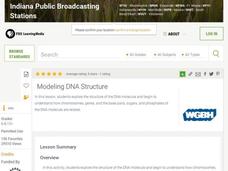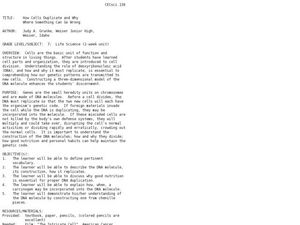Curated OER
Wellness and the Organic Food Movement
Twelfth graders examine their activities and discuss how they impact the environment. In groups, they research the organic food movement and discuss how it changed the type of foods eaten. To end the lesson plan, they examine the...
Curated OER
Canine Companions
Students research and complete activities about dogs. In this dog lesson, students read information about dogs to examine their traits, behavior, language, characteristics, and genetics. Students take a quiz about the information.
Curated OER
Scientists Breed See-Through Frogs
Young scholars participate in a pre-reading activity, then read a news article about the breeding of transparent frogs. In this biology and current events lesson, the teacher introduces the article with a question and a vocabulary...
Curated OER
Modeling DNA Structure
Students build their own DNA molecules using candy. In this science lesson, students build DNA molecules using licorice and gumdrops. The lesson includes the use of streaming videos from the teacher's domain.
Curated OER
Chromosomes, DNA, and Genes-Roadmap To Understanding The Foundation Of Genetics
Students investigate DNA by doing a hands on activity. In this activity lesson plan students participate in a lab that allows to explore DNA and chromosomes.
It's About Time
Is It Heredity or the Environment?
Himalayan rabbits are black when raised at low temperatures and white when raised at high temperatures. Young biologists participate in an experiment using seeds to demonstrate the ways the environment can influence an inherited...
Novelinks
Things Fall Apart: Problematic Situation
If you could pick characteristics you would want your child to possess, what would they be? To better understand Okonkwo, one of the key characters in Things Fall Apart, class groups engage in an activity that asks them to consider this...
Howard Hughes Medical Institute
Vertebrate Circulatorium
When you get to the heart of the matter, you learn a lot about an organism by studying its circulatory system! A perfect resource for a zoology or anatomy class, the simulation gives users a peek inside a variety of vertebrates to...
Gene Jury
DNA Detectives
Police find a man murdered in a local hotel, DNA everywhere, and now they need scholars' help. Budding detectives step into a crime scene playing the roles of victim, suspects, and investigators. They apply knowledge of criminology and...
Penguin Books
An Educator’s Guide to Chraisma by Jeanne Ryan
Often, science fiction makes a lot of connections to real life. An educator's guide for the novel Charisma by Jeanne Ryan, has readers discuss many of the real-life issues that come in the text. A brief summary helps garner interest in...
Howard Hughes Medical Institute
Lactose Intolerance: Fact or Fiction
Around the world, about 2/3 of adult humans are lactose intolerant. Scholars work in small groups to discuss a few statements about lactose intolerance. Then, they watch a video on the topic and readdress each statement. Whole-class...
Cold Spring Harbor Laboratory
Genes Get Shuffled When Chromosomes Exchange Pieces
Some genes link to others that have implications for inheritance. A set of resources lead pupils through the history of this discovery. They explain how chromosomes recombine and which parts are more susceptible to this linkage....
American Museum of Natural History
What's This? Staying Safe
Amaze the class with the creative adaptations species employ to trick predators. An online interactive lesson introduces learners to six different species with unique adaptations. Each species highlights a different adaptation and its...
American Museum of Natural History
Ocean Creature Feature
From coloring to hard protective shells, ocean creatures have adaptation features that help them survive. An eight-question online quiz highlights different ocean animals and their unique characteristics. The resource then offers pop-up...
Curated OER
The Theory of Evolution
In this theory of evolution worksheet, students review vocabulary words associated with evolution including the different types of evolution patters. This worksheet has 5 true or false and 5 matching questions.
Curated OER
Hardy-Weinberg Equilibrium According to Hoyle:
Students gain a feeling for the significance of the Hardy-Weinberg Equilibrium without using algebra but participating in an interactice game.
Curated OER
Taxonomy
Students analyze the complexity of organism classifications based on certain criteria. In this classifying organisms lesson students study taxonomy and gather information and leaves to do their own experiment on classification.
Curated OER
Dihybrid Punnett Squares
Students construct Punnett squares to illustrate specific genotypic and phenotypic genetic outcomes.
Students calculate the probability of achieving specific genotypic and phenotypic genetic oucomes, using dihybrid Punnett squares.
Curated OER
Human Heredity II
Using deductive skills and reasoning based on the data provided about a family's blood genotype, blood phenotype, chromosomes, and genetic conditions, 9th graders answer the questions below. The conditions discussed are Down Syndrome and...
Curated OER
Breeding Bunnies
Students learn the impact that genetics can have on the evolution of a population of organisms and become aware of the influence that the environment has onorganisms.
Curated OER
How Cells Duplicate and Why, Where Something Can Go Wrong
Seventh graders study cell division. They examine the role of deoxyribonucleic acid (DNA), and how and why it must replicate, is essential to comprehending how our genetic patterns are transmitted to new cells.
Curated OER
Science and Values: Using Science to Shape Our Future
Learners explore and discuss the link between values and science. They read several articles on such topics as global warming, cloning, genetically modified crops and animal testing and then identify the subjective aspect of science in...
Curated OER
Catch Up On Tomato Technology
Young scholars explore the ways in which technological advances have benefited tomatoes as a commodity. In a small group, students review information related to the selective breeding and genetic engineering of tomatoes. Groups compose a...
Curated OER
Peanut Butter Broccoli
Students explore selective breeding and genetic engineering. They illustrate that produce items have a wide variety of traits that can potentially be combined to produce a new food by creating a class graph.
Other popular searches
- Population Genetics
- Genetics Worksheets
- Mendelian Genetics
- Genetics Middle School
- Genetics Probability
- Genetics & Punnett Squares
- Genetics and Heredity
- Mendel Genetics
- Animal Genetics
- Introduction to Genetics
- Human Genetics
- Human Genetics Pedigree























